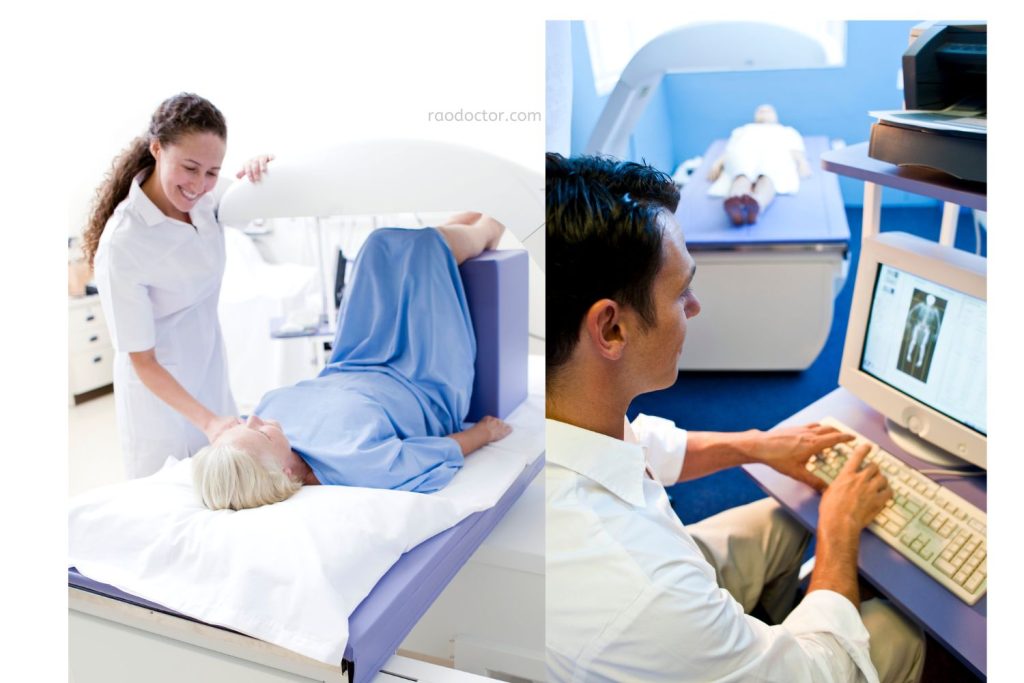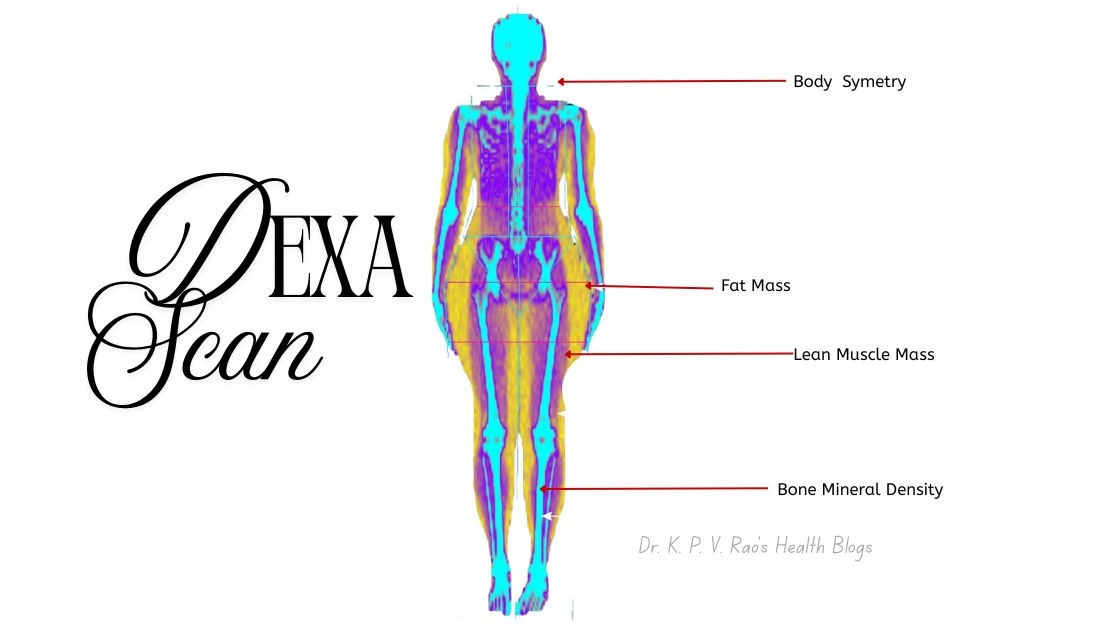Hello friends. Welcome to yet another useful article. Today we are going to learn about an imaging technique called the Dexa Scan.
What is a DEXA Scan?
A DEXA scan, or Dual-Energy X-ray Absorptiometry scan, is a medical imaging technique specifically designed to assess bone density and other body compositions.
Utilized primarily to evaluate the risk of osteoporosis and fractures, this scan employs two distinct energy levels of X-rays to ascertain the mineral content (calcium) present in bones and differentiate between lean muscle and fat mass in the body.
Its non-invasive nature makes it an attractive option for both patients and healthcare providers, as it requires no needles or injections, enabling a comfortable experience during the assessment.
The process of a DEXA scan is relatively straightforward. Patients lie flat on a scanning table while a machine passes over them, emitting a mixture of low-dose X-rays.
This technology not only provides accurate measurements of bone density but also effectively computes muscle and fat composition throughout the body.
During my own DEXA scan session, I observed the seamless operation of the equipment and the precision with which it analyzed my body composition, yielding results that helped me informed take health decisions.”
Doctors often recommend DEXA scans based on several factors, including age, gender, and medical history. For example, postmenopausal women and older adults are frequently advised to undergo this scan, given their increased risk of developing osteoporosis.
Furthermore, the results from a DEXA scan can serve as a baseline for tracking changes in bone density over time, especially for those undergoing treatment or lifestyle modifications aimed at improving bone health.
In short, the DEXA scan represents a valuable tool in the assessment of body composition, highlighting its essential role in monitoring bone health, muscle mass and body fats.
With its advanced technology and non-invasive approach, it continues to gain recognition in both clinical and research settings for its reliability and accuracy.
Let’s learn about this useful imaging technique today…
Indications for a DEXA Scan
Several indications exist for this essential diagnostic tool, which can significantly impact an individual’s health management and preventive care strategy.
Various factors, including age, gender, family history, medical conditions, and lifestyle choices, can guide your doctor in recommending a DEXA scan.
Individuals over the age of 50 are often advised to undergo periodic DEXA scans due to the increased risk of osteoporosis and related fractures associated with aging.
Research indicates that postmenopausal women are particularly vulnerable to bone density loss, warranting early screening to detect potential issues before they progress.
For men, while the risk is generally lower, those with conditions that may affect hormone levels or bone health, such as low testosterone, may also benefit from a DEXA scan.
Family history plays a notable role as well; patients with a history of osteoporosis or similar disorders in their family may be advised to schedule a DEXA scan, even if they do not exhibit symptoms.
Similarly, individuals with certain medical conditions, such as rheumatoid arthritis or those on long-term corticosteroid therapy, are at a heightened risk for bone density loss and should consider regular assessments through DEXA scans.”
Lifestyle choices can also influence the decision to initiate a DEXA scan.
Factors such as excessive alcohol consumption, smoking, and a sedentary lifestyle can all contribute to poor bone health, prompting healthcare providers to recommend a DEXA scan to monitor the patient’s condition.”
By identifying at-risk individuals through these various indications, healthcare professionals can implement timely interventions to promote long-term health and wellness.
What does a dexa scan show?
Interpreting the findings from a DEXA scan, or Dual-Energy X-ray Absorptiometry scan involves understanding the measurements of bone density, muscle mass, and body fat percentage.
These scans produce comprehensive reports that can guide healthcare providers in assessing a patient’s health status, particularly concerning osteoporosis and body composition.
The primary focus of a DEXA scan is the measurement of bone mineral density (BMD), which is evaluated against established reference values to determine the risk of fractures and bone diseases.
Typically, bone density results are presented as T-scores and Z-scores.
The T-score compares an individual’s bone density to that of a healthy young adult. A score of -1.0 or higher is considered normal, +/-1.0 to -2.5 indicates low bone density (osteopenia), and -2.5 or lower signifies osteoporosis.
Z-scores compare the patient’s bone density with that of age-matched peers, which can be particularly valuable for diagnosing bone health in younger populations.
Besides bone density, a DEXA scan assesses body composition by measuring fat mass and lean mass. The results report the percentage of body fat, which is crucial for determining overall health risks.
For adults, body fat percentages typically considered healthy range from 10-20% for men and 18-28% for women. Values outside these ranges can indicate obesity or underweight conditions, which may necessitate further investigation or lifestyle modifications.
Healthcare professionals interpret these findings in conjunction with patient history and other diagnostic tests. Factors such as age, gender, and ethnicity influence these values, and thus reference ranges are adjusted accordingly to provide personalized health assessments.
This nuanced approach ensures that individuals receive tailored recommendations aimed at improving or maintaining their bone health and overall body composition.
Preparing for a dexa scan
If your doctor has advised you a Dexa Scan, You have to follow these instructions:
- Avoid eating or drinking anything except water for at least 4 hours before the scan.
- Inform your doctor if you are pregnant, suspect you might be, or have a history of allergies to contrast material.
- Remove any jewelry, glasses, or other items that might interfere with the scan.
- Discuss any medications you are taking with your healthcare provider, as some may need to be paused.
- Arrive early to complete any necessary paperwork and relax before the scan.
Steps in carrying out a Dexa Scan

- Lie down on the scanning table, usually on your back [as shown above]. The technician will position your body in alignment with the scanner.
- Remain still during the scan, which typically lasts about 10-30 minutes.
- The machine will take images of your bones, often focusing on the hip and spine.
- After the scan, you can get dressed and resume normal activities.
- The results will be analyzed and shared with you in a follow-up appointment.
How to read a dexa bone density scan?
Bone density results are crucial indicators of an individual’s bone health, typically derived from a dual-energy X-ray absorptiometry (DEXA) scan.
This non-invasive imaging technique measures the density of minerals in bones, providing a detailed analysis through two key parameters: T-scores and Z-scores [see the image below].

Understanding these scores can assist in assessing one’s fracture risk and overall skeletal health.
The T-score compares an individual’s bone density to that of a healthy young adult, serving as a crucial benchmark.
A T-score of -1.0 or higher indicates normal bone density, while scores between -1.0 and -2.5 suggest low bone density, known as osteopenia.
A T-score of -2.5 or lower classifies an individual as having osteoporosis, significantly increasing the risk of fractures.
Therefore, higher T-scores reflect better bone health, while lower scores indicate the necessity for intervention to prevent complications.
On the other hand, the Z-score evaluates bone density in relation to one’s age, sex, and ethnicity. This score helps identify whether the bone density is appropriate for the individual’s body build profile.
A Z-score below -2.0 is often considered below average and may prompt further investigation to explore underlying health issues affecting bone density, particularly in younger individuals. In contrast, a Z-score between -2.0 and +2.0 is typically regarded as normal.
Thus, both T-scores and Z-scores derived from a DEXA scan play significant roles in understanding one’s bone health.
Why and when does your doctor suggest a Dexa Scan?
The above mentioned dexa scan scores can help your doctor determine whether you have any bone health issue [e.g. osteoporosis] or body fats [obesity] and muscle mass issues like sarcopenia.
Tracking your progress is like keeping score in a game; it guides your strategy for improving performance and making smart choices to strengthen your defense against potential setbacks such as osteoporosis and sarcopenia and enhancing skeletal strength and reducing the risk of fractures. .
Useful Resource- DXA body composition analysis
We will stop here and learn more about this useful imaging technique in my next article.
In the meantime, if you have found this article useful, do share it with your friends on social media icons at the bottom of this article or Click to Tweet below-
Dexa Scan- What is it and it's uses Share on XAdios. See you in my next article. This has been published now. You can click here to access it- Benefits of Dexa Scan.
You can get my recent articles in your mailbox by joining my email list below:

